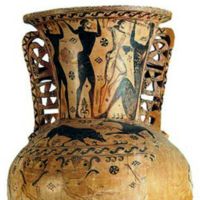Entrance 2
Point Item Type Metadata
Latitude
40.90411
Longitude
25.51424
MobileContent
During our time, and on a trip back to the mythical ages, the history of the region emerges while reading again a Homeric verse: Odysseus, after the capture of Troy and his wanderings in the unknown and rich places of Asia Minor, during his return journey to Ithaki, ran aground the coast of ancient Ismaros. Maronas, a priest of the local temple of Apollo, offered to Odysseus sweet wine, among other gifts, a specific sweet type of wine which was produced locally. It was that same wine which Odysseus offered to the Cyclops Polyphemus in order to make him drunk, while he was trapped in Polyphemus’ cave, so for Odysseus and his companions to escape from the Cyclops’ cave while hooked on goats.
Protoattic amphora attributed to the "Painter of Polyphemus." This is the largest known protoattic vase, which was used for the burial of a child. Around the vase’s neck, the scene of the blinding of Polyphemus from Odysseus is depicted. Lastly, today the vase is located at the Archaeological Museum of Eleusis and it is dated approximately during 660 BC.
Protoattic amphora attributed to the "Painter of Polyphemus." This is the largest known protoattic vase, which was used for the burial of a child. Around the vase’s neck, the scene of the blinding of Polyphemus from Odysseus is depicted. Lastly, today the vase is located at the Archaeological Museum of Eleusis and it is dated approximately during 660 BC.
SpeechContent
Let’s start talking about the history and the characteristics of the region.
During our time, and on a trip back to the mythical ages, the history of the region emerges, while reading again a Homeric verse,: Let us remember then Odysseus, who after the capture of Troy, and his wanderings in the unknown and rich places of Asia Minor during his return journey to Ithaki, ran aground the coast of ancient Ismaros. Maronas,, a priest of the local temple of Apollo, offered to Odysseus sweet wine,, among other gifts,, a specific sweet type of wine which was produced locally. It was that same wine, which Odysseus offered to the Cyclops Polyphemus, in order to make him drunk, while he was trapped in Polyphemus’ cave, so for Odysseus and his companions to escape from the Cyclops’ cave, while hooked on goats.
Look now at this impressive vase. This is a protoattic amphora, which is attributed to the "Painter of Polyphemus." This is the largest known protoattic vase, which was used for the burial of a child. If you pay attention, you could see that around the vase’s neck, there is the scene of the blinding of Polyphemus from Odysseus. Lastly, today the vase is located at the Archaeological Museum of Eleusis, and it is dated approximately during 660 BC.
During our time, and on a trip back to the mythical ages, the history of the region emerges, while reading again a Homeric verse,: Let us remember then Odysseus, who after the capture of Troy, and his wanderings in the unknown and rich places of Asia Minor during his return journey to Ithaki, ran aground the coast of ancient Ismaros. Maronas,, a priest of the local temple of Apollo, offered to Odysseus sweet wine,, among other gifts,, a specific sweet type of wine which was produced locally. It was that same wine, which Odysseus offered to the Cyclops Polyphemus, in order to make him drunk, while he was trapped in Polyphemus’ cave, so for Odysseus and his companions to escape from the Cyclops’ cave, while hooked on goats.
Look now at this impressive vase. This is a protoattic amphora, which is attributed to the "Painter of Polyphemus." This is the largest known protoattic vase, which was used for the burial of a child. If you pay attention, you could see that around the vase’s neck, there is the scene of the blinding of Polyphemus from Odysseus. Lastly, today the vase is located at the Archaeological Museum of Eleusis, and it is dated approximately during 660 BC.
Entrance
TextDuration
1:20
Characterization
TH
Files
Collection
Citation
“Entrance 2,” iGuide Repo, accessed December 5, 2025, http://ubuntu01.ceti.gr/omeka/items/show/1661.
Item Relations
| This Item | dcterms:isPartOf | Item: Entrance 2 |

